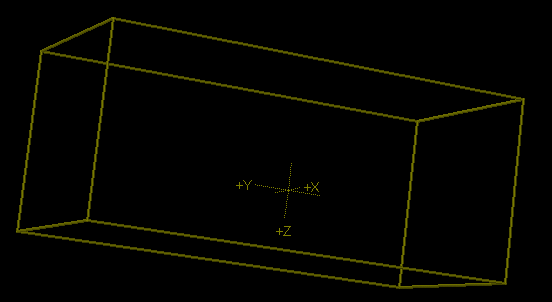As you will have seen from the comments, Peter Corbett knows what it is – and quite rightly isn’t saying. But no other response. What does an author do when all the readers are lurkers? Here’s the first strategy – lure them on. So here’s a clue to keep you interested.
This is the unit cell of the crystal with the axes drawn correctly and precisely. I shan’t give them exactly as that would allow you to look them up (more on that later).

However if you are adventurous you can measure them and deconstruct the perspective and probably get quite good ratios.
The picture is, of course, thanks to Jmol – a Blue Obelisk member.
-
Recent Posts
-
Recent Comments
- pm286 on ContentMine at IFLA2017: The future of Libraries and Scholarly Communications
- Hiperterminal on ContentMine at IFLA2017: The future of Libraries and Scholarly Communications
- Next steps for Text & Data Mining | Unlocking Research on Text and Data Mining: Overview
- Publishers prioritize “self-plagiarism” detection over allowing new discoveries | Alex Holcombe's blog on Text and Data Mining: Overview
- Kytriya on Let’s get rid of CC-NC and CC-ND NOW! It really matters
-
Archives
- June 2018
- April 2018
- September 2017
- August 2017
- July 2017
- November 2016
- July 2016
- May 2016
- April 2016
- December 2015
- November 2015
- September 2015
- May 2015
- April 2015
- January 2015
- December 2014
- November 2014
- September 2014
- August 2014
- July 2014
- June 2014
- May 2014
- April 2014
- March 2014
- February 2014
- January 2014
- December 2013
- November 2013
- October 2013
- September 2013
- August 2013
- July 2013
- May 2013
- April 2013
- March 2013
- February 2013
- January 2013
- December 2012
- November 2012
- October 2012
- September 2012
- August 2012
- July 2012
- June 2012
- May 2012
- April 2012
- March 2012
- February 2012
- January 2012
- December 2011
- November 2011
- October 2011
- September 2011
- August 2011
- July 2011
- May 2011
- April 2011
- March 2011
- February 2011
- January 2011
- December 2010
- November 2010
- October 2010
- September 2010
- August 2010
- July 2010
- June 2010
- May 2010
- April 2010
- August 2009
- July 2009
- June 2009
- May 2009
- April 2009
- March 2009
- August 2008
- July 2008
- June 2008
- May 2008
- April 2008
- March 2008
- February 2008
- January 2008
- December 2007
- November 2007
- October 2007
- September 2007
- August 2007
- July 2007
- June 2007
- May 2007
- April 2007
- December 2006
- November 2006
- October 2006
- September 2006
-
Categories
- "virtual communities"
- ahm2007
- berlin5
- blueobelisk
- chemistry
- crystaleye
- cyberscience
- data
- etd2007
- fun
- general
- idcc3
- jisc-theorem
- mkm2007
- nmr
- open issues
- open notebook science
- oscar
- programming for scientists
- publishing
- puzzles
- repositories
- scifoo
- semanticWeb
- theses
- Uncategorized
- www2007
- XML
- xtech2007
-
Meta
Not lurking, Peter – just baffled and in chronic suspenders … um .. suspense. I’m also still waiting for the denouement of the previous sets of mystery molecules …
(1) daen – that’s great. Every comment on this list is really valuable as otherwise I have no idea whether it’s worth continuing posting…
The earlier mystery molecules were connected (a) because they all came from chemical blogs (Tenderbutton, Totally Synthetic, Org Prep Daily and Useful Chem, I think) and (b) because I had hidden an InChI in them (as alt tag).
I am sitting with Jim Downing here – Jim is not a chemist – but he is tackling this very intelligently and has narrowed the search down. Not yet enough.
The other thing this shows, of course, is that Data needs to be Open. For example if I gave the cell dimensions you would have to use CCDC to search. When we have an Open knowledge base of crystallography – not too far away now – we will be able to search that way.
If I get more readers commenting like you, I’ll give some more help… 🙂
I bet the molecule is a rather beautiful [… clues deleted by PMR…]. I know couple of synthetic chemists who isolated the stuff in a great yield and purity but were rather puzzled by its NMR spectra…
To not to laugh at others misfortune, I was once doing a BF3-catalyzed reaction in tetrahydrofuran as a solvent and obtained a great quantity of a low-melting (30C)hygroscopic crystalline solid. I re-crystallized it to a perfect purity. It was (CH2CH2CH2CH2O)n , a THF oligomer.
(3) Well done Milkshake! That’s about 4 readers to get it. I think you, like Peter Corbett, knew what it was – others have either got there by intuition or some form of search. I think the molecule is laughing at all of us!